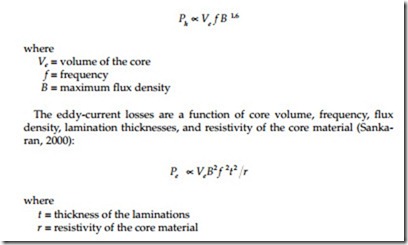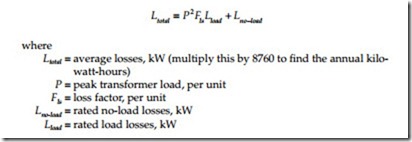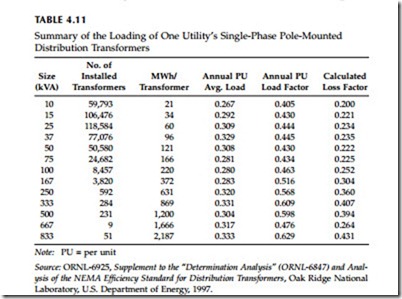Losses
Transformer losses are an important purchase criteria and make up an appreciable portion of a utility’s overall losses. The Oak Ridge National Laboratory estimates that distribution transformers account for 26% of transmission and distribution losses and 41% of distribution and subtransmission losses (ORNL-6804/R1, 1995). At one utility, Grainger and Kendrew (1989) esti- mated that distribution transformers were 55% of distribution losses and 2.14% of electricity sales; of the two main contributors to losses, 86% were no-load losses, and 14% were load losses.
Load losses are also called copper or wire or winding losses. Load losses are from current through the transformer ’s windings generating heat through the winding resistance as I2R.
No-load losses are the continuous losses of a transformer, regardless of load. No-load losses for modern silicon-steel-core transformers average about 0.2% of the transformer rating (a typical 50-kVA transformer has no- load losses of 100 W), but designs vary from 0.15 to 0.4% depending on the needs of the utility. No-load losses are also called iron or core losses because they are mainly a function of the core materials. The two main components of no-load losses are eddy currents and hysteresis. Hysteresis describes the memory of a magnetic material. More force is necessary to demagnetize magnetic material than it takes to magnetize it; the magnetic domains in the material resist realignment. Eddy current losses are small circulating cur- rents in the core material. The steel core is a conductor that carries an alternating magnetic field, which induces circulating currents in the core. These currents through the resistive conductor generate heat and losses. Cores are typically made from cold-rolled, grain-oriented silicon steel lam- inations. Manufacturers limit eddy currents by laminating the steel core in 9- to 14-mil thick layers, each insulated from the other. Core losses increase with steady-state voltage.
Hysteresis losses are a function of the volume of the core, the frequency, and the maximum flux density (Sankaran, 2000):
Amorphous core metals significantly reduce core losses — as low as one quarter of the losses of silicon-steel cores — on the order of 0.005 to 0.01% of the transformer rating. Amorphous cores do not have a crystalline structure like silicon-steel cores; their iron atoms are randomly distributed. Amorphous materials are made by rapidly cooling a molten alloy, so crystals do not have a chance to form. Such core materials have low hysteresis loss. Eddy current-losses are very low because of the high resistivity of the material and very thin laminations (1-mil thick). Amorphous-core transformers are larger for the same kVA rating and have higher initial costs.
Load losses, no-load losses, and purchase price are all interrelated. Approaches to reduce load losses tend to increase no-load losses and vice versa. For example, a larger core cross-sectional area decreases no-load losses (the flux density core is less), but this requires longer winding conductors and more I2R load losses. Table 4.10 shows some of the main tradeoffs.
Information from transformer load management programs can help with transformer loss analysis. Table 4.11 shows typical transformer loading data from one utility. The average load on most transformers is relatively low (25 to 30% of transformer rating), which highlights the importance of no-load losses. The total equivalent losses on a transformer are
Many utilities evaluate the total life-cycle cost of distribution transformers, accounting for the initial purchase price and the cost of losses over the life of the transformer (the total owning cost or TOC). The classic work done by Gangel and Propst (1965) on transformer loads and loss evaluation provides the foundation for much of the later work. Many utilities follow the Edison Electric Association’s economic evaluation guidelines (EEI, 1981). To evalu- ate the total owning cost, the utility’s cost of losses are evaluated using transformer loading assumptions, including load factor, coincident factor, and responsibility factor. Utilities typically assign an equivalent present value for the costs of no-load losses and another for the cost of load losses. Loss values typically range from $2 to $4/W of no-load losses and $0.50 to $1.50/W of load losses (ORNL-6847, 1996). Utilities that evaluate the life costs of transformers purchase lower-loss transformers. For example, a 50-
kVA single-phase, non-loss-evaluated transformer would have approximately 150 W of no-load losses and 675 W of load losses; the same loss- evaluated transformer would have approximately 100 W of no-load losses and 540 W of load losses (ORNL-6925, 1997). Nickel (1981) describes an economic approach in detail and compares it to the EEI method. The IEEE has developed a more recent guide (C57.12.33).



